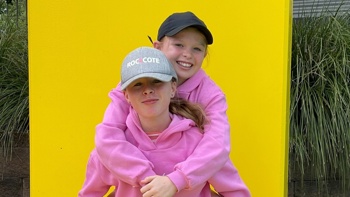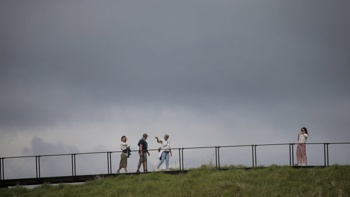Scientists have edged closer to understanding mysterious “silent” earthquakes, after capturing a recent event that raised part of Hawke’s Bay’s seafloor by several centimetres.
Only discovered in the last few decades, “slow-slip” events are effectively earthquakes that unfold in slow motion – but packing the power to shift faults by tens of centimetres over days, weeks or months.
Because they’ve been also shown to precede subduction zone cataclysms – including Japan’s devastating 9.1 “megathrust” quake and tsunami in 2011 – researchers believe they could be key to forecasting major disasters.
Recent programmes that have deployed dozens of seafloor sensors along our own subduction zone, and drawing around $70m in funding, have turned New Zealand into something of a global slow-slip event observatory.
Like its global counterparts, the Hikurangi Subduction Zone – where the Pacific Plate dives, or subducts, westward beneath the North Island – is thought capable of generating quakes measuring over 9.0.
/cloudfront-ap-southeast-2.images.arcpublishing.com/nzme/4OUXNHJES4D6SWRM5BND7MVI4U.jpg)
The Hikurangi Subduction Zone marks the margin where the the Pacific Plate dives - or subducts - westward beneath the North Island. Image / GeoNet
Slow-slip events happen to be relatively-frequent occurrences along this sprawling boundary, occurring at shallow depths off the East Coast, but also at deeper levels off Manawatū and Kāpiti regions, releasing pent-up energy equivalent to a 7.0 quake.
Now, a team of scientists have gained a clearer picture of one of these events in action near the coast of Hawke’s Bay, where there’d been little direct measurement of them to date.
Back in 2018, a team of Kiwi, US and Japanese researchers dropped sophisticated pressure sensors across northern and central parts of the subduction zone, where they continuously recorded data on the seafloor until being collected late the following year.
- 'Significant impact': Warning of more foul weather in storm-battered areas
- Hawke's Bay conservation project worth six million
/cloudfront-ap-southeast-2.images.arcpublishing.com/nzme/Q4SVRDYT5NHUFJEOH4IICCBYO4.jpg)
Slow-slip events occur in an area where the Hikurangi Subduction Zone is transitioning from being "stuck" beneath the southern North Island, to an area where the subduction zone is "creeping" further north, around Gisborne and Hawkes Bay. Image / GeoNet
“These pressure sensors can be used to detect vertical displacement of the seafloor because the seafloor pressure changes in response to changes in the height of the overlying water column,” explained study leader Dr Katie Woods, who carried out the work while completing her PhD at Victoria University of Wellington.
“If the seafloor subsides, the height of the water column above the seafloor sensors increases, which is recorded as an increase in pressure - and vice versa for uplift of the seafloor.”
Generally, if a slow-slip event occurred directly beneath these sensors, the seafloor could be expected to rise as a result, while registering on the sensors as a decrease in pressure.
When dealing with dynamic natural processes at the bottom of the ocean, where strong currents could cloud the data, getting a clear view of one of these quakes wasn’t easily done.
But in their study, just published in the Journal of Geophysical Research: Solid Earth, Woods and her colleagues were able to draw on sophisticated oceanographic models to remove much of that background “noise” - enabling them to make one of New Zealand’s most detailed descriptions of a slow quake.
In all, the event, which lasted between March and June 2019, was shown to raise the seafloor by as much as 3.3cm.
“One of the particularly interesting results was observing what might be happening at the central margin,” Woods said.
“Prior to this study, no seafloor geodetic sensors had been deployed at the offshore Hawke’s Bay area so we didn’t know anything about slow-slip event behaviour here.”
Further, the data showed the quake may have even shifted to shallower areas of the subduction interface.
“It seemed to suggest that these events can happen very close to the Hikurangi Trench, near where the plate boundary emerges at the seafloor off Hawke’s Bay, which is similar to what we see near Gisborne,” said study co-author Dr Laura Wallace, of GNS Science.
“Also, events here appear to happen over a much longer time period than we’d thought,” adding that events in this area were too far out from the coast to be picked up by geodetic instruments on land.
“So, you can actually hide a lot of slow-slip quakes out there without ever detecting them.”
/cloudfront-ap-southeast-2.images.arcpublishing.com/nzme/TTRPMVMIJRZ4FTESSQS4Q3ILAM.jpg)
GNS Science scientist Dr Laura Wallace describes subduction zones like Hikurangi as "the biggest earthquake and tsunami factories on the planet". Photo / GNS Science
Having permanent seafloor monitoring in these areas could help fill in what could be a crucial blind spot.
“Generally, this study shows how we’ve moved a step closer to being able to measure these things off-shore, beneath the oceans, which has been a huge challenge facing our scientists,” Wallace said.
“In terms of looking at the potential for future earthquake risk, we really do need to get a handle on the relationship between these slow-slip events and earthquake processes – especially in these places that we can’t monitor in any other way.”
Unravelling the slow-slip enigma is growing increasingly important, with the most recent research indicating a 26 per cent chance of an event 8.0 or larger striking beneath the lower North Island within the next 50 years.
The potential impacts of such a disaster were troubling: one EQC-commissioned report estimated a one-in-500-year event could cause tens of thousands of fatalities and injuries, along with tens of billions of dollars of property loss.
Scientists are now tackling the puzzle from several directions, through studies focused on seafloor measurements, mathematical modelling and tell-tale traces of ancient earthquakes gleaned from tiny ocean creatures that lived thousands of years ago.
Specifically, they’re interested in answering why slow-slip quakes tend to happen in regular cycles – something that could be due to the fault zone reaching some form of threshold after being constantly loaded with stress by plate motion, or being primed by a build-up of water underground.
“We’re slowly filling in these gaps, but studies like Katie’s bring us closer.”
Take your Radio, Podcasts and Music with you









